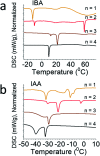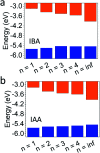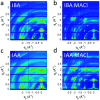Long periodic ripple in a 2D hybrid halide perovskite structure using branched organic spacers
- PMID: 34094428
- PMCID: PMC8162985
- DOI: 10.1039/d0sc04144k
Long periodic ripple in a 2D hybrid halide perovskite structure using branched organic spacers
Abstract
Two-dimensional (2D) halide perovskites have great promise in optoelectronic devices because of their stability and optical tunability, but the subtle effects on the inorganic layer when modifying the organic spacer remain unclear. Here, we introduce two homologous series of Ruddlesden-Popper (RP) structures using the branched isobutylammonium (IBA) and isoamylammonium (IAA) cations with the general formula (RA)2(MA) n-1Pb n I3n+1 (RA = IBA, IAA; MA = methylammonium n = 1-4). Surprisingly, the IAA n = 2 member results in the first modulated 2D perovskite structure with a ripple with a periodicity of 50.6 Å occurring in the inorganic slab diagonally to the [101] direction of the basic unit cell. This leads to an increase of Pb-I-Pb angles along the direction of the wave. Generally, both series show larger in-plane bond angles resulting from the additional bulkiness of the spacers compensating for the MA's small size. Larger bond angles have been shown to decrease the bandgap which is seen here with the bulkier IBA leading to both larger in-plane angles and lower bandgaps except for n = 2, in which the modulated structure has a lower bandgap because of its larger Pb-I-Pb angles. Photo-response was tested for the n = 4 compounds and confirmed, signaling their potential use in solar cell devices. We made films using an MACl additive which showed good crystallinity and preferred orientation according to grazing-incidence wide-angle scattering (GIWAXS). As exemplar, the two n = 4 samples were employed in devices with champion efficiencies of 8.22% and 7.32% for IBA and IAA, respectively.
This journal is © The Royal Society of Chemistry.
Conflict of interest statement
There are no conflicts to declare.
Figures









Similar articles
-
Nucleation and Crystallization in 2D Ruddlesden-Popper Perovskites using Formamidinium-based Organic Semiconductor Spacers for Efficient Solar Cells.Angew Chem Int Ed Engl. 2023 Dec 11;62(50):e202314690. doi: 10.1002/anie.202314690. Epub 2023 Nov 8. Angew Chem Int Ed Engl. 2023. PMID: 37877629
-
Novel Series of Quasi-2D Ruddlesden-Popper Perovskites Based on Short-Chained Spacer Cation for Enhanced Photodetection.ACS Appl Mater Interfaces. 2018 Jun 6;10(22):19019-19026. doi: 10.1021/acsami.8b03517. Epub 2018 May 24. ACS Appl Mater Interfaces. 2018. PMID: 29741083
-
Two-Dimensional Ruddlesden-Popper Perovskite with Nanorod-like Morphology for Solar Cells with Efficiency Exceeding 15.J Am Chem Soc. 2018 Sep 19;140(37):11639-11646. doi: 10.1021/jacs.8b04604. Epub 2018 Sep 10. J Am Chem Soc. 2018. PMID: 30157626
-
Charge-Carrier Transport in Quasi-2D Ruddlesden-Popper Perovskite Solar Cells.Adv Mater. 2022 Feb;34(7):e2106822. doi: 10.1002/adma.202106822. Epub 2022 Jan 5. Adv Mater. 2022. PMID: 34676930 Review.
-
2D Hybrid Halide Perovskites: Structure, Properties, and Applications in Solar Cells.Small. 2021 Oct;17(43):e2103514. doi: 10.1002/smll.202103514. Epub 2021 Sep 30. Small. 2021. PMID: 34590421 Review.
Cited by
-
Additive Engineering for Stable and Efficient Dion-Jacobson Phase Perovskite Solar Cells.Nanomicro Lett. 2023 May 24;15(1):134. doi: 10.1007/s40820-023-01110-9. Nanomicro Lett. 2023. PMID: 37221320 Free PMC article. Review.
-
Elucidation of the suppression of photoinduced segregation in 2D mixed halide, A2PbI2Br2: Critical role of A2PbBr4 photostability.iScience. 2025 Mar 4;28(4):112154. doi: 10.1016/j.isci.2025.112154. eCollection 2025 Apr 18. iScience. 2025. PMID: 40171486 Free PMC article.
-
Structural chemistry of layered lead halide perovskites containing single octahedral layers.IUCrJ. 2021 Jun 30;8(Pt 4):485-513. doi: 10.1107/S2052252521005418. eCollection 2021 Jul 1. IUCrJ. 2021. PMID: 34258000 Free PMC article. Review.
References
-
- Ball J. M. Lee M. M. Hey A. Snaith H. J. Energy Environ. Sci. 2013;6:1739–1743. doi: 10.1039/C3EE40810H. - DOI
LinkOut - more resources
Full Text Sources
Research Materials

